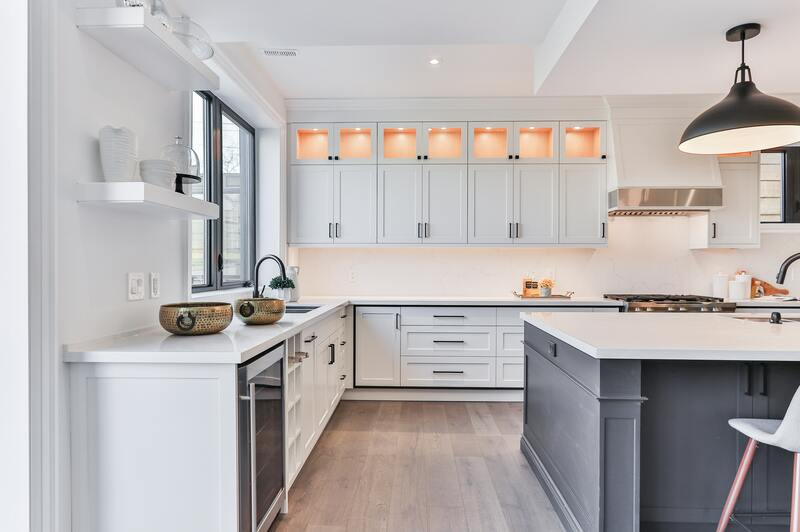Do you need to know how to repair water damaged kitchen cabinet toe for your place? We have here the four steps to do that and how to prevent further and future damages and infestation.
Piping for both incoming and wastewater from kitchens is so sophisticated these days that you wouldn’t know where they are when you first look through a particular house. They’ve been hidden from site and access for aesthetics and to keep them safe from stresses that can cause damage.

Nevertheless, there are times when these hidden pipes can get moved and therefore have leakage. Unfortunately, as they’re in areas we don’t commonly look at, such leakage can already be eating away at other kitchen fixtures, particularly the cabinets.
Steps On Repairing Water-damaged Kitchen Cabinet Toe
Water damage on kitchen furniture is quite common since a lot of water is cycled through it daily. There are high chances of leaking pipes from old age, faulty connections, and misalignment from earthquakes and storms.
When there’s excessive water around, you’ll get worried about it seeping into furniture, especially wooden ones. For kitchen cabinets, leaks from the floor are to first break into their feet.
Here are the steps you must get familiar with to repair the toe of your kitchen cabinet.
Step #1. Inspect the toe and note the damage extent
Prior to repair, you must first understand how much of the part is damaged. This will allow you to plan for the amount of material needed, what materials you’ll need, and mainly if the level of damage is within a repairable extent.
In your inspection, make sure you also check the state of the toe kicks and the entire cabinet (especially the back and underside), whether they’ve also sustained considerable damage. You can leave their repair for later if they’re not in as dire a state as the toes.
The best way to go with this is to empty and place the cabinet in an open space so you can work freely. To check the toe and underside, you can prop up the cabinet up a table or anything similar to elevate it.
During the inspection, another critical thing to note is where the water causing damage is pooling from, and make sure to deal with that immediately. After taking the cabinet out, seal the leak first or call a plumber, then clean and dry the area.
Step #2. Detach the damaged toes
If more than one toe has water damage, detach them from the cabinet with proper tools. Depending on how they’re attached, if we’re assuming the cabinet is wood, it can be screws, nails, or wood glue and adhesive.
Make sure you remove all the connections correctly before pulling off the toes to make sure you don’t cause further damage.
Step #3. Fix or replace the damaged toes
For extensive damages on the bottom part of the toe, you can cut off the damaged part and then finish it. However, you’ll need to even out the height change with all the toes, even the undamaged ones, so you’d probably need to detach all the toes.
Another way is to replace the entire damaged toe. Find a similar wood type, then cut and shape it to match the original toe.
For multiple damaged toes, you may buy an entire piece of wood so they have a similar load capacity. After shaping, make sure you smoothen with sandpaper.
Step #4. Reattach the newly finished parts
After all the toes have finished, you can now reattach them to the cabinet’s bulk. You can use the same screws as the original if they’re in a good state or replace them with similar ones.
If the cabinet needs fixing, you can do that first, especially on the downside, so the new toes won’t get in the way.
Apply a suitable adhesive on the parts prior to connection, following the product’s instructions. This will add strength and sturdiness to the link.
After attaching all the toes, test out the balance of the new toes by laying the cabinet flat on the floor. Adjust the imbalance accordingly with sandpaper and refinish the toes.
Coat each toe with varnish or other protective coatings in the shade similar to the cabinet and original pieces. Let the toes dry and apply at least two to three layers of coating, with enough drying in between.
That’s it; you’ve now repaired the cabinet’s toes! You can also check out “how to fix the finish on water damaged kitchen cabinets” so you can fix another cabinet part.
How to protect kitchen cabinets from water damage
Preventing water damage comes down to regular maintenance and inspection of piping, roof, ceiling, and other water sources, especially after storms and earthquakes.
There can also be cases of frequent water splashing accidents, mainly if your kitchen receives high traffic daily or if you have children. In such cases, you can refinish and recoat the cabinet with suitable protective products against water.
Note that proper maintenance keeps rot away and lengthens the useful life of your furniture. It can also help prevent mold and other dangerous organisms from thriving in your home.
Water damage may be present in many forms, but rotting is one of the most prolific ones. Check this article that answers how long does it take for mold to rot wood next.
Conclusion
We’ve finished finding out how to repair water damaged kitchen cabinet toe and how to protect them against future damages. Wooden cabinets are aesthetic and beautifully aging pieces, and it’s just right that you care well for them.
